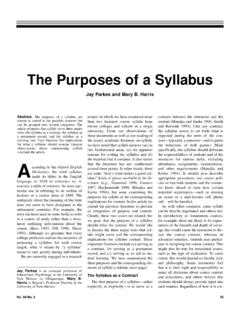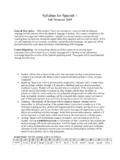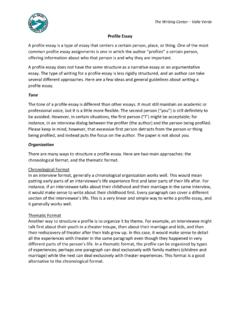Transcription of A Natural Approach to Chemistry - Lab-Aids
1 Lab-Aids Correlations to A Natural Approach to Chemistry Washington 9-12 EALRs 1-4 A Natural Approach to Chemistry (NAC) is written by Hsu, Chaniotakis, Carlisle, and Damelin, This correlation is intended to show selected locations in NAC programs that support the Washington EALRs for 9-12. It is not an exhaustive document; other citations for the Essential Academic Learning Requirements (EALR) may exist that are not listed here. This document was prepared by Mark Koker, Ph D, Director of Curriculum and Training at Lab-Aids .
2 A Natural Approach to Chemistry is published by, and available exclusively from, Lab-Aids , Ronkonkoma NY, For more information about this correlation or for questions about review copies, presentations, or any matters related to sales or service, please contact Gail Vaughn, Regional Sales Manager by e-mail at by phone at (925) 270-7413; or visit us on the web at EALR 1: Systems Big Idea: Systems (SYS) Core Content: Predictability and Feedback In prior grades students learned how to simplify and analyze complex situations by thinking about them as systems.
3 In grades 9-12 students learn to construct more sophisticated system models, including the concept of feedback. Students are expected to determine whether or not systems analysis will be helpful in a given situation and if so, to describe the system, including subsystems, boundaries, flows, and feedbacks. The next step is to use the system as a dynamic model to predict changes. Students are also expected to recognize that even the most sophisticated models may not accurately predict how the real world functions. This deep understanding of systems and ability to use systems analysis is an essential tool both for scientific inquiry and for technological design.
4 2 Content Standards Performance Expectations Location in NAC Where Assessed1 Students know that: Students are expected to: 9-12 SYSA Feedback is a process in which the output of a system provides information used to regulate the operation of the system. Positive feedback increases the disturbance to a system. Negative feedback reduces the disturbance to a system. Give examples of a positive feedback system and explain its regulatory mechanism ( , global warming causes Earth s ice caps to melt, reflecting less energy to space, increasing temperatures).
5 Give examples of a negative feedback system and explain its regulatory mechanism ( , when a human body overheats, it produces sweat that cools the body by evaporation). , Le Chatelier s principal; chemical equilibria is a vital principle for human health blood Chemistry and acid/base buffers carbon cycle and carbon sequestra-tion 9-12 SYSB Systems thinking can be especially useful in analyzing complex situations. To be useful, a system needs to be specified as clearly as possible. Determine if a systems Approach will be helpful in answering a question or solving a problem.
6 Represent the system with a diagram specifying components, boundaries, flows, and feedbacks. Describe relevant subsystems and the larger system that Environ- mental monitoring , pH in the environ-ment, pH of buffered systems , Chemistry of photo- 1 Relevant questions from the student book (SB) and lab manual (LM) problem sets and questions are indicated, , SB 18-30, 51-55; LM 9A Pt 4a-c; 9B Pts 3-5 3 Content Standards Performance Expectations Location in NAC Where Assessed1 Students know that: Students are expected to: contains the system being analyzed.
7 Determine how the system functions with respect to other systems. synthethis and respira-tion, Krebs cycle 9-12 SYSC In complex systems, entirely new and unpredictable properties may emerge. Consequently, modeling a complex system in sufficient detail to make reliable predictions may not be possible. Create a simplified model of a complex system. Trace the possible consequences of a change in one part of the system and explain how the simplified model may not be adequate to reliably predict consequences. The global carbon cycle and carbon se-questration 9-12 SYSD Systems can be changing or in equilibrium.
8 Analyze whether or not a system ( , population) is changing or in equilibrium. Determine whether a state of equilibrium is static or dynamic ( , inflows equal outflows). chemi-cal equili-brium, atmospheric nitrogen , cave Chemistry (calcium carbonates) 4 EALR 2: Inquiry Big Idea: Inquiry (INQ) Core Content: Conducting Analyses and Thinking Logically In prior grades students learned to revise questions so they can be answered scientifically. In grades 9-12 students extend and refine their understanding of the nature of inquiry and their ability to formulate questions, propose hypotheses, and design, conduct, and report on investigations.
9 Refinement includes an increased understanding of the kinds of questions that scientists ask and how the results reflect the research methods and the criteria that scientific arguments are judged by. Increased abilities include competence in using mathematics, a closer connection between student-planned investigations and existing knowledge, improvements in communication and collaboration, and participation in a community of learners Content Standards Performance Expectations Location in NAC Where Assessed2 Students know that: Students are expected to: 9-12 INQA Scientists generate and evaluate questions to investigate the Natural world.
10 Generate and evaluate a question that can be answered through a scientific investigation. Critique questions generated by others and explain whether or not the questions are scientific. , LM 1A, 11A, 12A, 12B (see also all A type labs) Not addressed SB 18-30, pp. 32-33; 51-55, p. 34; 57, p. 34 LM 1A, Pts 3-4, p. 2; 11A Pt 6; 12A: Pt 6 ; 12B Pts 4, 6 p. 97-98 2 Relevant questions from the student book (SB) and lab manual (LM) problem sets and questions are indicated, , SB 18-30, 51-55; LM 9A Pt 4a-c.









